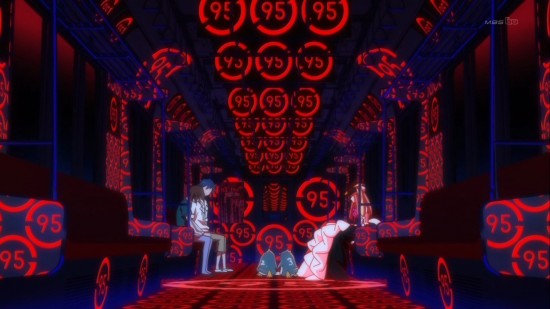In Japanese it is customary to leave out the subject or the object of a sentence if it can be inferred from the context. Perhaps as an extension of this principle, Japanese writers usually disdain to spell out anything that the audience members should be able to figure out for themselves. Western anime fans are accustomed to the experience of watching an anime and saying “Huh? What the heck happened?”
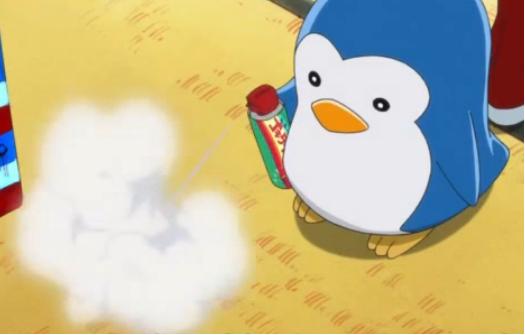
The true fan will accept this. Sometimes I have to watch an anime 2 or 3 times before I feel that I really understand it. If the anime is good enough I don’t mind, and if it isn’t I probably wouldn’t have watched it all the way through even once. (A native Japanese viewer, with a better grasp of the underlying cultural assumptions, could probably figure it out in a single viewing.)
In more serious literature, beyond manga, anime and light novels, things are less simple. In a typical Haruki Murakami fantasy we may be left with the understanding that something supernatural has taken place but there is no way to be sure exactly what happened or who did it or why. (The universe is more complicated than we imagine and it doesn’t come with a manual.)
Mawaru Penguindrum enters this territory. (Writer/Director Kunihiko Ikuhara is clearly a fan of Murakami’s stories.) It’s all very surreal. Some of the scenes that we see are clearly symbolic while others are supposed to be “really happening” in the context of the story, and it’s often unclear what is supposed to be real and what isn’t.
I’m going to make an attempt to sort out what story elements we are supposed to take literally and what is only symbolic. Two warnings: first, I’m not 100% sure about any of this. Second, everything below is loaded with spoilers and you really would do better to watch the show before reading this.
The Boxes
I’m pretty sure that none of the characters were ever actually physically imprisoned in boxes. Sanetoshi explicitly spells out what the boxes represent:
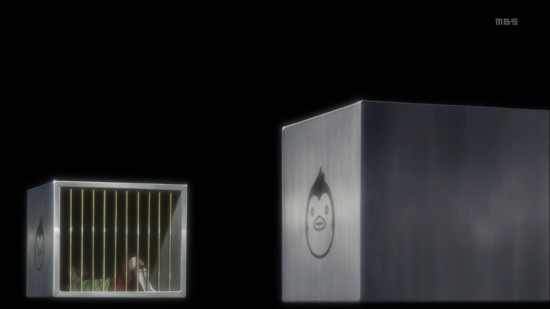
“I realized one morning that I hate this world. This world is made of countless boxes. People bend and stuff their bodies into their own boxes and stay there for the rest of their lives. And eventually inside the box they forget: What they looked like. What they loved; whom they loved. That’s why I’m getting out of my box. I’m one of the Chosen. That’s why I’m going to destroy this world.”
So basically the boxes symbolize the same thing as the A-T fields in Neon Genesis Evangelion, and Sanetoshi’s solution is much like the one offered in Evangelion: liberate people from their boxes by killing them. (Clearly Ikuhara disagrees.)
The Child Broiler
I’m also pretty sure that the world of the story does not actually have an institution where unwanted children are ground up into shiny crystalline shards, thus turning them into “invisible entities” who are “indistinguishable from everyone else.” The surreal imagery and the heavy-handed symbolism scream “this is a metaphor!”
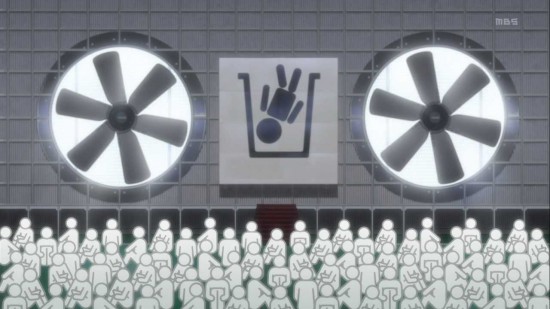
Some viewers think that this is a symbolic representation of an actual orphanage or foster-care system, but I think even that is too literal. There is no reason to think that Keiju would be sent to an orphanage just because his mother lost interest in him. The Child Broiler represents the despair that children feel when they don’t have their parents’ emotional support.
This implies that the scene where Momoko rescues Keiju from the Child Broiler did not literally occur as shown. Probably she did burn her hand but this was the result of using the Transfer of Fate spell. That might explain why Keiju was so slow to recognize the parallel scene when it occurred.
This raises a question about the parallel story of Yuri. When we see her sculptor father preparing to use a chisel on her, is that just a metaphor about parents who try to mold their children into some pre-determined ideal? Well yes, at some level this is clearly a metaphor. On the other hand we are told twice that there is something wrong with Yuri’s body, some sort of hidden scar or deformity. So probably in the context of the story he really did cut her.
The Kiga Apple
The Kiga Apple, a.k.a. “The Fruit of Fate” is the real key to getting out of the boxes or escaping from the Child Broiler. Is that just another metaphor that doesn’t literally exist?
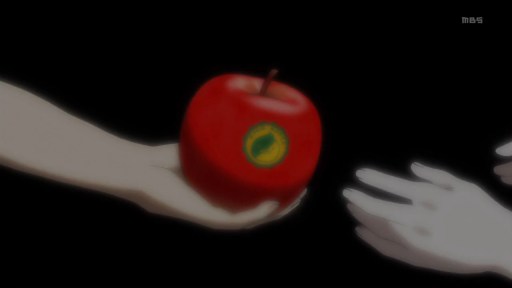
It does seem very symbolic, but it also seems pretty physical, what with the way those things are just lying around the Kiga Group headquarters and the Takakura household. Any why is it a Kiga apple anyway? Aren’t they the ones with the wrong answer?
So here’s an idea: maybe there really was an actual physical Kiga Apple which was used in Kiga Group initiation ceremonies. Perhaps the new members pledged to “share the fruit of Fate,” binding their destinies to that of the other members. It would make sense that Sanetoshi might have a distorted understanding of how the Fruit of Fate should work, even if only Momoka truly understood it.
(That might also explain his use of a “Penguin Force Apple” to create his ultimately ineffectual medicine.)
Rock Over Japan
The characters who experience it call the surreal world in which the Princess of the Crystal appears a “hallucination.” However it is clearly a shared hallucination, which is not what we normally mean when we say the word “hallucination.” Perhaps we should consider it another level of reality.
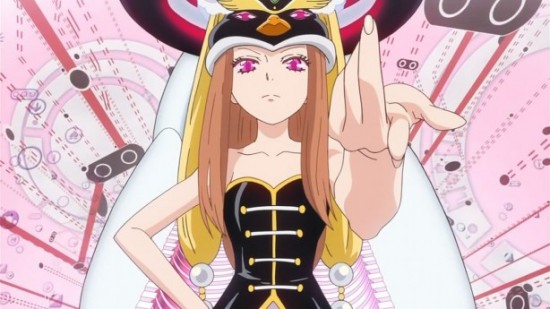
On the other hand I’m pretty sure that to an outside observer the characters would not be seen to vanish into another world. Probably they would be standing around, shouting at things that aren’t there.
The Library Annex
Himari visits the “Hole in the Sky Annex” in a dream, but apparently it isn’t just a dream since she brings an actual book back. Should we call it another level of reality?
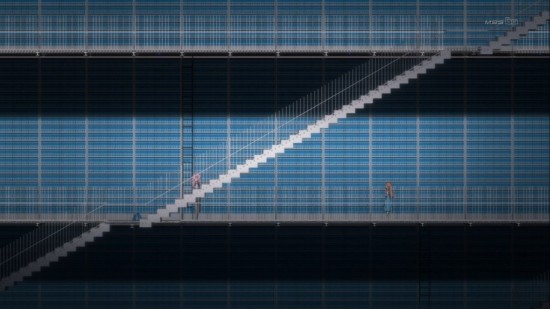
This probably is based on the “Akashic Records” which supposedly contain the history of everyone’s past lives. (“Akasha” is Sanskrit for “sky”.) The idea was popularized by the Theosophists, a group of 19th century Western mystics who apparently derived it from Hindu writings. As far as I know it is not part of any Buddhist traditions.
The Hospital Labyrinth
How about the surreal setting in which Masako confronts Kanba after kidnapping Shouma?. My first impression was that this was another “alternate reality” like the world of the Princess of the Crystal.
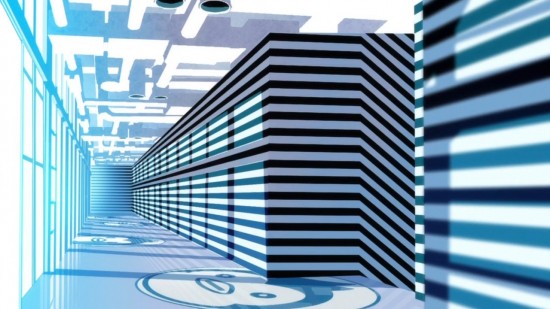
Then I changed my mind. Unlike the Princess of the Crystal, I don’t think that Masako (even with her access to Kiga Group technology) has the ability to make people hallucinate being in another world. Maybe this is just a metaphor for Kanba’s mental state as he is forced to confront his past.
Or maybe I’m being insufficiently literal. Masako is rich, clever and ruthless. Maybe she just arranged to have an empty part of the hospital redecorated in a way calculated to make Kanba freak out.
The 95 Train
What about the dark subway car lit only by glowing red “95” symbols that appears whenever Shouma talks or thinks about the 1995 terrorist attack? There’s no way that this could be literal. It symbolizes Shouma’s feelings of shame and despair.
